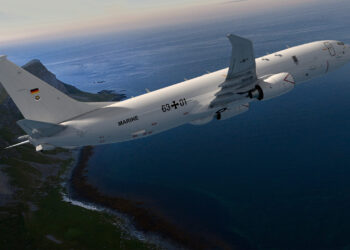Lockheed Martin,
RMV Will Provide Significant Capability
RIVIERA BEACH, Fla.(DefenceTalk): A ceremony today marked Lockheed Martin's delivery of the first production Remote Minehunting Vehicle (RMV) to the U.S. Navy.
This delivery is a significant milestone in the development of the mine countermeasures capability for both DDG 51 Arleigh Burke Class destroyers and the Littoral Combat Ship (LCS).
The RMV is a semi-submersible, semi-autonomous, unmanned vehicle that tows a variable-depth sensor to detect, localize, classify and identify bottom and moored sea mines at a safe distance from friendly ships. The RMV transmits real-time mine sonar images to its host ship over a data link system. This mine reconnaissance capability will allow a naval Strike Group Commander to quickly and safely assess the threat of mines in prospective areas of operations.
In 2005, the Naval Sea Systems Command awarded Lockheed Martin a low-rate initial production contract for three RMVs. In 2006, a contract for four more RMVs was awarded. Total contract value is $118 million. The RMV is produced at Lockheed Martin's Riviera Beach, FL facility.
The RMV is the integral mobile subsystem of the Navy's AN/WLD-1 Remote Minehunting System (RMS). The RMS includes the RMV, a launch and retrieval system for the RMV, the RMV-towed sonar sensor, advanced communications equipment and software that integrates RMS into the host ship's combat system.
The RMV is one component of the RMS which is currently installed on USS Bainbridge (DDG 96). The RMS completed an operational assessment in the summer of 2006 and a technical evaluation in March 2007. RMS is expected to conduct an Operational Evaluation in June of this year. The RMS is scheduled for its first operational deployment aboard USS Bainbridge in late 2007.
“The Remote Minehunting System (RMS) introduces a critical mine countermeasure capability to our forward-deployed naval forces,” said Captain Joe Spitz, Deputy Mine Warfare Program Manager, Program Executive Office Littoral and Mine Warfare. “Sailors now have an organic unmanned mine warfare system that will allow them to detect and classify mines from a safe distance. RMS allows the Navy to send a remotely operated vehicle into dangerous waters, keeping Sailors out of the minefield.”
“I am extremely proud of our Lockheed Martin and Navy team for successfully reaching this key milestone,” said Fred P. Moosally, president of Lockheed Martin's Maritime Systems and Sensors business. “It marks the delivery of a significant capability to the Navy that will help keep our sailors and ships out of harm's way. This technologically advanced product delivers a critical capability to the Strike Group Commander, which will result in improved battle space awareness.”
Headquartered in Bethesda, MD, Lockheed Martin employs about 140,000 people worldwide and is principally engaged in the research, design, development, manufacture, integration and sustainment of advanced technology systems, products and services.









